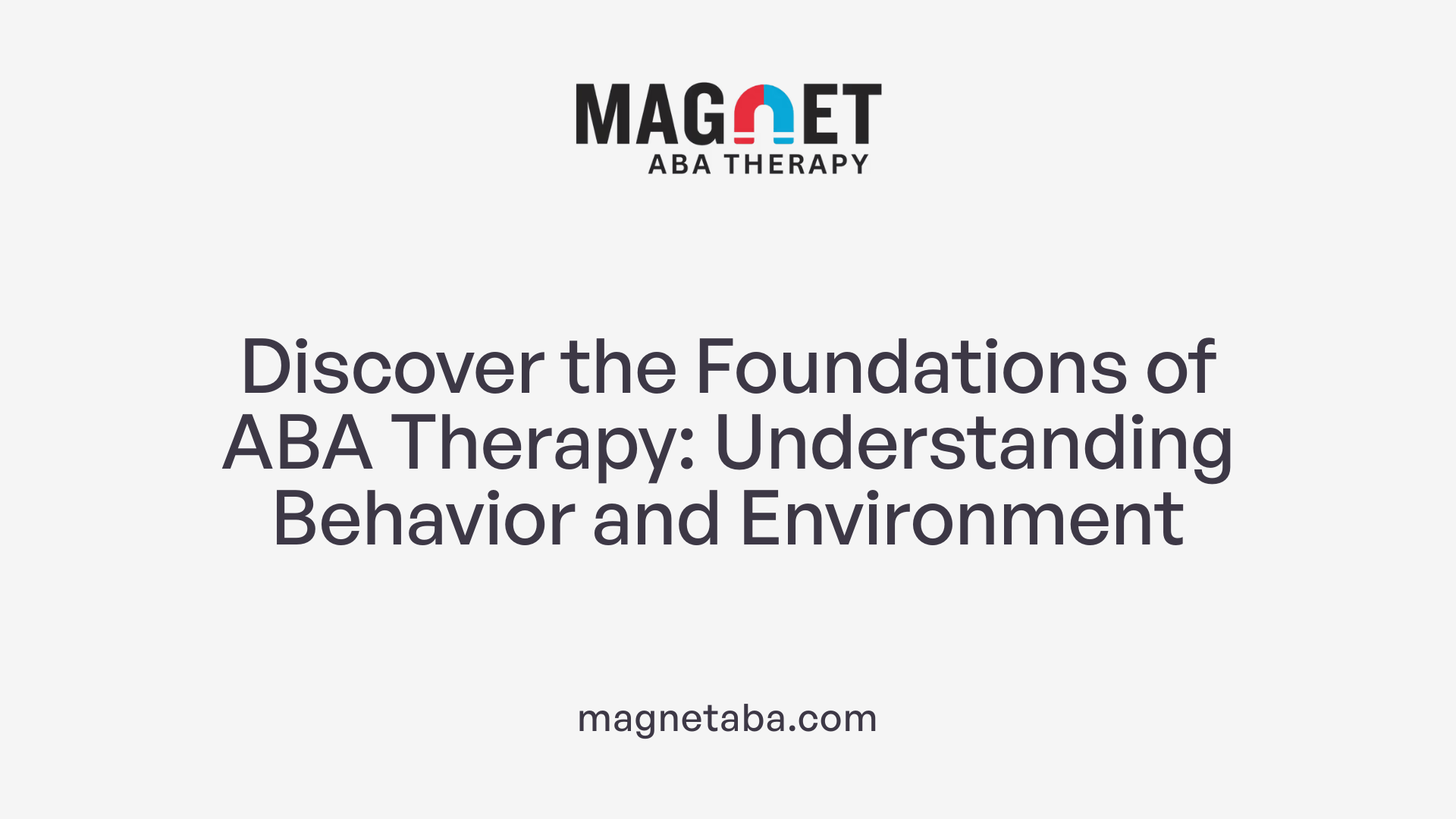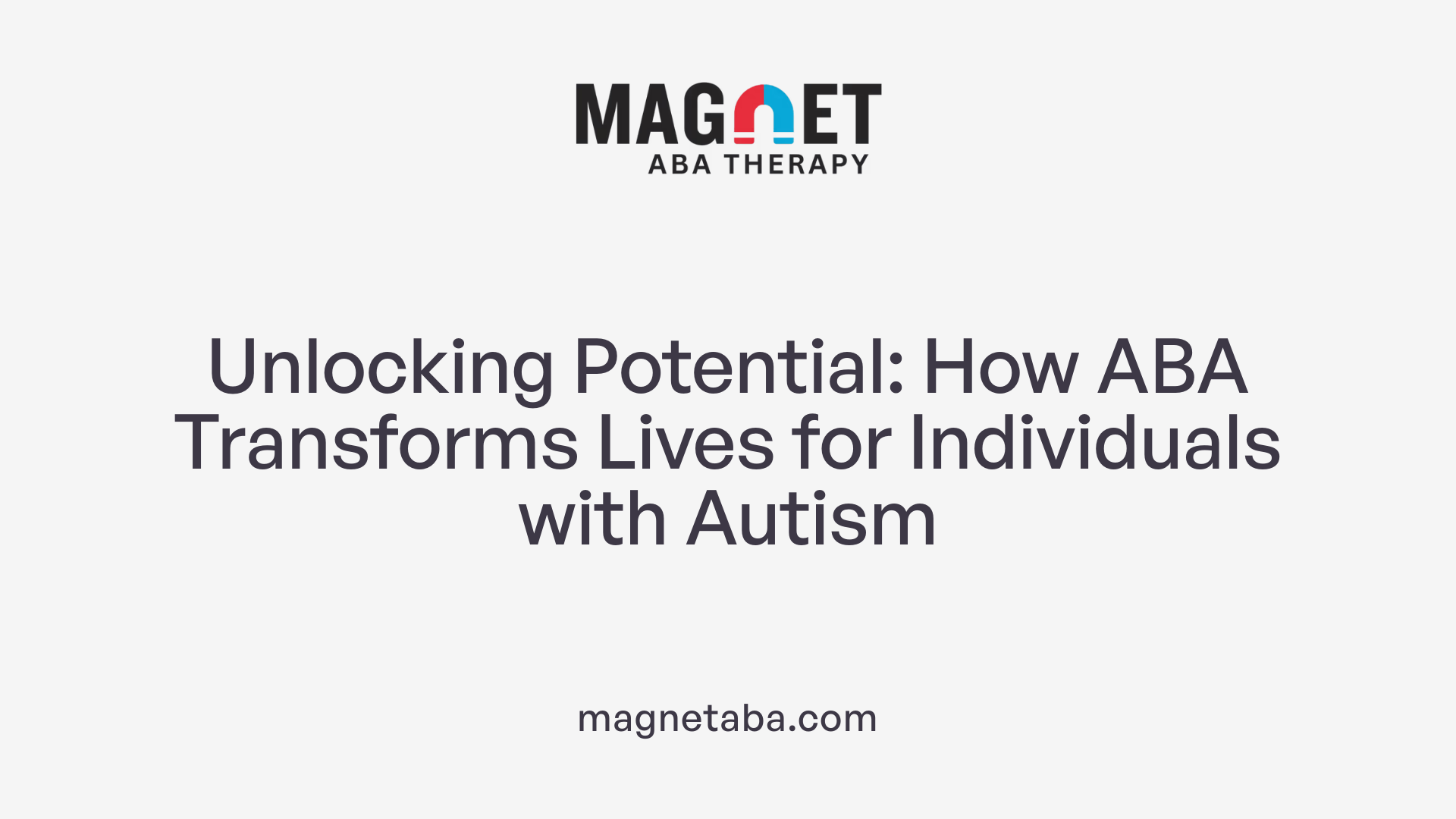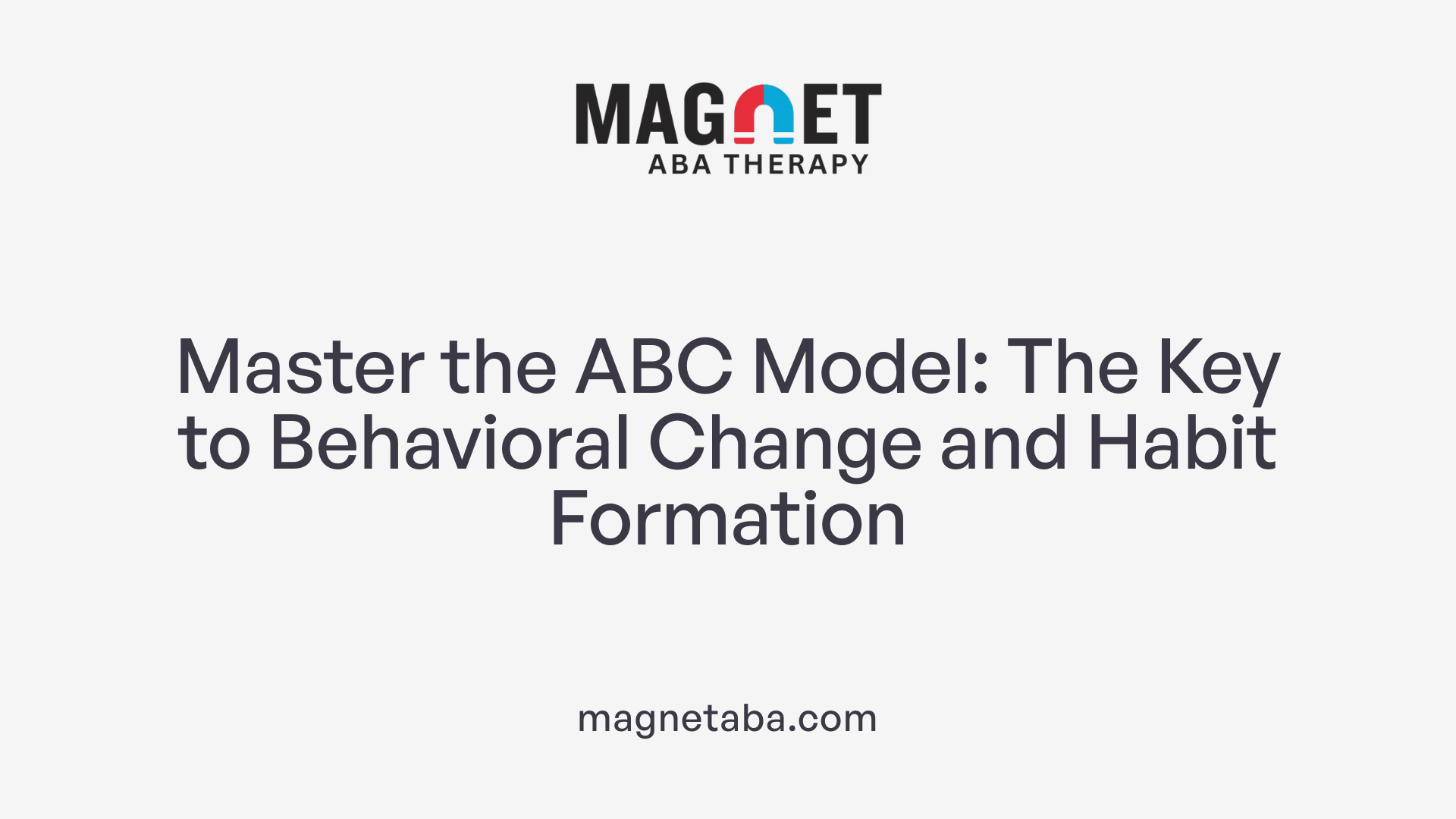Understanding the Foundations of ABA Therapy
Applied Behavior Analysis (ABA) represents a scientifically grounded approach to supporting individuals with autism spectrum disorder (ASD). By analyzing behavior through learning principles and environmental influences, ABA helps develop vital skills while reducing problematic behaviors. This article explores the tools and methodologies of ABA that effectively teach healthy habits, illustrating how therapy sessions are designed, delivered, and assessed to optimize outcomes for those on the spectrum.
What is Applied Behavior Analysis (ABA) Therapy?

Understanding ABA Therapy
Applied Behavior Analysis (ABA) therapy is a science-based treatment designed to understand how behavior works and how it is influenced by the environment. Primarily used to support individuals with autism spectrum disorder (ASD), ABA therapy aims to increase helpful behaviors while reducing those that interfere with learning and daily life.
Focus on Behavior Science
ABA relies on principles of learning theory and operant conditioning. One central method is positive reinforcement, where rewards follow desirable behaviors to encourage their repetition. The therapy also uses the 'ABC' model — Antecedent, Behavior, Consequence — to analyze what triggers behaviors and what results from them, enabling targeted behavior change.
Methods and Flexibility
ABA programs are highly adaptable to individual needs and can be delivered across various settings including home, school, and community environments. Key methods include Discrete Trial Training, the Early Start Denver Model, and Pivotal Response Treatment, each tailored to promote skills like communication, social interaction, attention, and self-care. Progress is closely monitored through data collection to fine-tune interventions.
Role of Behavior Analysts
A Board Certified Behavior Analyst (BCBA) assesses the individual’s skills, needs, and preferences and designs a personalized ABA program. The BCBA oversees ongoing therapy to ensure it meets the child’s goals effectively.
ABA therapy's evidence-based approach and customizable nature make it a recognized best practice for helping children with autism develop essential life skills and reduce problem behaviors.
Core Benefits of ABA Therapy for Individuals with Autism

How does ABA therapy benefit individuals with autism?
ABA therapy benefits individuals with autism through a scientific and structured approach that focuses on teaching and reinforcing helpful behaviors. It uses positive reinforcement, where rewards follow desired behaviors to encourage their recurrence, which leads to improvements in communication, social skills, attention, and daily living abilities.
Enhancements in Communication and Social Skills
ABA programs target critical skill areas such as language, communication, social interaction, and academic skills. By using tailored techniques, ABA helps individuals develop improved communication methods, better interaction with peers, and stronger social skills. This fosters more meaningful connections and supports participation in community settings.
Behavior Reduction Techniques
A core goal of ABA is to reduce harmful or hindering behaviors. This is achieved by analyzing the Antecedent-Behavior-Consequence (A-B-C) model to understand what triggers certain behaviors and modifying environmental factors accordingly. Through consistent reinforcement and behavioral strategies, problematic behaviors decrease, allowing for improved overall functioning.
Skill Development Focus Areas
ABA emphasizes specific skill development such as self-care, play, leisure activities, motor skills, and academics. Progress is carefully tracked with data collection methods to ensure continual improvement. Individualized goals are set based on each person's unique needs, promoting gradual growth in targeted areas.
Individualized Therapy Impact
ABA's flexibility allows therapy to be adapted to individual preferences and skill levels. Qualified behavior analysts (BCBAs) design personalized programs that can be implemented in various environments including home, school, and community settings. This personalized approach enhances the therapy’s effectiveness and relevance for each individual.
Evidence Backing ABA Effectiveness
ABA is supported by numerous scientific studies and is recognized internationally as an evidence-based best practice treatment for autism. Research reveals significant positive outcomes in intellectual functioning, communication, social skills, and adaptive behavior after ABA interventions. While more rigorous large-scale studies are needed, early and comprehensive ABA programs have demonstrated consistent developmental benefits, reinforcing its role as a leading autism therapy.
Qualifications and Roles of ABA Therapy Providers
Who provides ABA therapy and what qualifications do they typically have?
ABA therapy is delivered by a team of trained professionals, each playing a unique role in treatment.
Board Certified Behavior Analysts (BCBAs) are the primary designers and supervisors of ABA programs. They usually hold a master's degree in behavior analysis or related fields such as psychology or education. BCBAs conduct detailed behavioral assessments, develop individualized intervention plans, monitor progress, and provide supervision to other team members.
Board Certified Assistant Behavior Analysts (BCaBAs) support BCBAs by assisting in program development and supervision but require less extensive training.
Registered Behavior Technicians (RBTs) carry out day-to-day therapy implementation under the guidance of BCBAs. They work directly with clients to apply ABA techniques, collect data on behaviors and progress, and contribute important information to guide decision-making.
Paraprofessionals and other support staff may assist with therapy delivery, usually under close supervision.
All ABA professionals must obtain certification from the Behavior Analysis Certification Board (BACB), which mandates specific education, supervised experience, and ongoing continuing education to ensure up-to-date, ethical, and effective practice.
Why is family collaboration and ethical practice important?
Family involvement is crucial in ABA therapy to support consistency across environments and to tailor interventions to individual needs and preferences. Providers collaborate closely with families to set goals and share progress.
Ethical practice is a cornerstone of ABA, guided by professional codes to respect client dignity, confidentiality, and wellbeing. Qualified providers follow these standards to ensure safe, respectful, and effective therapy outcomes.
Typical Components of an ABA Therapy Session
What does an ABA therapy session typically involve?
An ABA therapy session typically involves a set of structured activities designed specifically around the child's unique learning needs. These activities focus on building essential skills such as communication, social interaction, self-care, and cognitive abilities.
Therapists employ various teaching methods including discrete trial training, which breaks skills into small, manageable steps, and naturalistic teaching, which uses everyday situations to promote learning. Role-playing and interactive games like matching or sensory play are common tools to engage children and reinforce new abilities.
Throughout the session, positive reinforcement is a central strategy. This involves giving praise, tokens, or preferred items immediately following desired behaviors to encourage their repetition and mastery.
Moreover, sessions often include training for parents and caregivers. This ensures that the behavioral techniques learned can be consistently applied outside therapy, fostering better generalization of skills across environments.
In summary, an ABA therapy session is a mix of carefully planned exercises, behavior management techniques, and collaboration with families to support meaningful, individualized progress.
Analyzing and Modifying Behavior: The ABC Model

What Are the Principles of the ABC Model?
The ABC model is a foundational framework in Applied Behavior Analysis (ABA) designed to analyze and modify behavior effectively. It breaks down behavior into three components:
- Antecedent (A): What happens right before the behavior.
- Behavior (B): The actual action or response exhibited.
- Consequence (C): What follows the behavior, influencing its future occurrence.
This structure helps practitioners understand what triggers behaviors and which outcomes encourage or discourage them.
What Are Antecedent Triggers?
Antecedents are events or environmental factors that activate or cue a behavior. These triggers can be things like instructions, environmental changes, or emotional states. Recognizing antecedents allows therapists to modify or control these triggers to reduce unwanted behaviors or encourage positive ones.
How Is Behavior Described?
In ABA, behavior refers to any observable and measurable action an individual performs. Precise descriptions enable clear identification and tracking. For example, instead of noting "child is disruptive," the behavior is defined specifically, such as "child shouts loudly during class."
What Are Consequences and How Does Reinforcement Work?
Consequences follow the behavior and affect its repetition. ABA relies heavily on positive reinforcement, where a rewarding consequence immediately follows a desired behavior, encouraging it to happen again. Conversely, reducing or removing rewards after undesired behaviors helps decrease those actions.
How Is the ABC Model Applied in Behavior Change?
By analyzing the antecedent triggers and consequences linked to behaviors, practitioners create targeted interventions. For instance, if a child shows aggression when overwhelmed by noise (antecedent), introducing calming strategies or modifying the environment can prevent the trigger. Similarly, rewarding calm responses strengthens positive behaviors.
How Does the ABC Model Support Teaching Healthy Habits?
The model is effective in teaching essential skills such as hygiene, communication, and social interaction. Behaviors like handwashing can be broken down: the antecedent could be before meals, the behavior is washing hands properly, and the consequence is praise or a small reward. Over time, positive reinforcement embeds these healthy habits naturally.
Through the ABC framework, ABA offers a structured, adaptable method to foster skill development and reduce problem behaviors by understanding and shaping the behavior patterns in everyday contexts.
State-of-the-Art Technology Enhancing ABA Therapy

How is digital data collection and analysis used in ABA therapy?
Modern ABA therapy incorporates digital tools such as computers and smartphones to collect and analyze behavioral data efficiently. This digital data collection helps behavior analysts track progress more precisely and tailor interventions to individual needs.
What telehealth options are available for delivering ABA therapy?
Telehealth services enable ABA therapy to be provided remotely using webcams and online platforms. This approach improves access to therapy, especially for individuals living in remote or underserved areas, by removing barriers related to travel and availability of providers.
How do virtual reality (VR) and augmented reality (AR) contribute to ABA therapy?
VR and AR technologies immerse children in simulated real-world social scenarios to help improve social skills and emotional responses. These immersive environments create safe yet realistic settings for practicing interactions, enhancing learning and generalization.
In what ways are mobile apps used within ABA?
Mobile applications support the teaching and reinforcement of daily habits such as hygiene by using engaging animations and videos. These apps help motivate children and provide interactive learning experiences that complement traditional therapies.
How does wearable technology support ABA programs?
Wearable devices like smartwatches monitor physical activity, sleep patterns, and stress levels, providing valuable behavioral data that professionals can use to better understand and support each child’s needs.
What role do AI and machine learning play in ABA therapy?
Artificial Intelligence and machine learning technologies are leveraged to boost engagement and develop social skills. Studies show that robots and AI-driven tools can enhance attention and involvement in children with autism, offering personalized and responsive interaction.
Technological advancements in ABA therapy offer personalized interventions, greater efficiency, and expanded access to services. While these innovations advance therapy outcomes, considerations such as privacy, training, and costs remain important for successful integration.
Evidence-Based Outcomes and Effectiveness of ABA Therapy
How is the effectiveness of ABA therapy measured?
The effectiveness of ABA therapy is primarily gauged through systematic and continuous data collection. Practitioners use tools such as direct observations, checklists, questionnaires, and rating scales to track progress. Methods include baseline data establishment, ongoing progress monitoring, and employing standardized tools like the Verbal Behavior Milestones Assessment and Placement Program (VB-MAPP).
Data visualization via graphs and detailed progress reports help communicate improvements in behaviors, social skills, communication, and daily living abilities. Additionally, caregiver feedback and sample contributions enrich the accuracy of assessments. Electronic medical records and regular screenings during routine check-ups further support the consistent and early detection of challenges, enabling timely interventions.
Research support and meta-analysis
Substantial scientific research underpins ABA’s effectiveness, with a majority of studies reporting positive outcomes in areas such as cognition, communication, and adaptive behaviors. Meta-analyses confirm that early, intensive, and comprehensive ABA treatments yield significant improvements, though effectiveness can vary across cases. However, the field acknowledges a need for more rigorous randomized controlled trials (RCTs) to strengthen the evidence base, as many studies currently use single-case designs with smaller samples.
Areas with strongest gains
ABA therapy shows notable gains in intellectual functioning, language development, social skills, and daily living skills. Approximately 63-88% of research cases report improvements in these domains, reflecting ABA’s broad spectrum impact on children with autism spectrum disorder (ASD).
Limitations and challenges in research
Despite robust findings, limitations include scarce RCTs and limited comparisons of ABA directly against other interventions without relying solely on skill mastery as an outcome. The variability in study designs and sample sizes calls for further high-quality, large-scale research to validate and refine ABA approaches.
Importance of quality of life measures
A significant research gap lies in the lack of studies measuring the quality of life (QoL) for children undergoing ABA therapy, which is critical for assessing long-term, meaningful benefits. Ongoing research is encouraged to include QoL assessments to provide a fuller picture of therapy impact.
International recognition and endorsements
ABA is internationally recognized as a best practice for treating ASD and is endorsed by prominent health authorities across North America. The strong evidence base supports its use in improving skills and reducing challenging behaviors, making it a widely recommended treatment approach worldwide.
Personalizing ABA to Teach Healthy Daily Living Skills
Targeting Self-Care and Hygiene
ABA therapy plays a vital role in teaching self-care and hygiene skills by breaking down complex tasks into manageable steps. These tasks include brushing teeth, hand washing, dressing, and toileting. Programs tailor these skills to the individual's current abilities and needs, ensuring a personalized approach that encourages mastery.
Promoting Independence Through Behavior Shaping
Behavior shaping techniques in ABA gradually guide individuals toward independence in daily living activities. Therapists reinforce successive approximations of the desired behavior, such as completing parts of a routine correctly, until full independence is achieved. This method enhances confidence and functional autonomy.
Use of Technology for Habit Formation
Modern ABA integrates technology like mobile applications featuring engaging animations and videos that promote the learning of hygiene and daily living habits. Wearable devices track behaviors such as hand washing frequency or sleep patterns, providing real-time data to therapists. These innovations make habit formation interactive and measurable.
Role of Reinforcement in Health Habits
Positive reinforcement remains central in ABA for building healthy behaviors. Rewards, such as praise or preferred activities, immediately following desired behaviors increase the likelihood of their recurrence. This approach motivates consistent practice of self-care routines and healthy habits.
Integrating Social and Motor Skills
Daily living skills are often combined with social and motor skill development in ABA programs. For instance, group activities can improve both social interaction and motor coordination while practicing tasks like meal preparation. This holistic integration supports overall functional development and better generalization across environments.
Accessibility and Delivery of ABA Services
Therapy in Various Settings: Home, School, Community
Applied Behavior Analysis (ABA) therapy is designed with flexibility to meet individual needs. It can be effectively provided in multiple environments such as the home, school, and community settings. This versatility ensures that the therapy fits naturally into the individual's daily life, which helps with skill generalization and consistent progress.
Impact of Telehealth on Access
Technological advances have significantly broadened access to ABA therapy. Telehealth services, utilizing webcams and online platforms, enable remote delivery of ABA. This has been especially beneficial for individuals living in remote, rural, or underserved areas who might otherwise face barriers to receiving therapy. Remote sessions maintain continuity of care and provide opportunities for ongoing monitoring and adjustment.
Insurance and Medicaid Coverage Variations
Insurance coverage for ABA therapy varies widely. Some private insurance plans may cover ABA if deemed medically necessary. Meanwhile, Medicaid often provides coverage for children under 21 years of age, facilitating access to essential treatment. Families should review their insurance policies carefully to understand the extent of support available.
Importance of Provider Selection and Family Input
Selecting a qualified behavior analyst (BCBA) to design and oversee the ABA program is critical. Families are encouraged to actively participate by consulting medical providers, verifying insurance options, locating appropriate providers, and asking relevant questions. This collaborative approach ensures the therapy is tailored to the child’s unique skills and preferences, enhancing effectiveness.
Addressing Barriers Through Flexible Programs
ABA's adaptability allows programs to be personalized to overcome common barriers such as location, scheduling, and specific individual needs. By customizing interventions and utilizing technology, programs can accommodate diverse circumstances and maximize accessibility and engagement.
Future Directions in ABA Therapy and Healthy Habit Development

How Are Emerging Technologies Enhancing Engagement in ABA Therapy?
Technology is revolutionizing ABA therapy by making interventions more interactive and personalized. Tools such as tablets, communication devices, and mobile applications engage children through animations and videos, promoting healthy habits like hygiene in an enjoyable way. Moreover, wearable technology like smartwatches collects data on physical activity and stress levels, offering professionals real-time insights to adapt treatment plans.
What Advances Are Shaping Remote and Virtual Therapy Models?
Telehealth platforms, including webcam-based sessions, have significantly expanded access to ABA, especially for families in remote or underserved locations. Virtual and augmented reality systems immerse children in realistic social scenarios, enhancing social skills and emotional understanding. These innovations facilitate therapy beyond traditional settings, fostering skill generalization in real-world contexts.
Why Is There a Need for More Rigorous Research, Including Quality of Life Measures?
While numerous studies confirm the effectiveness of ABA in improving cognition, language, and social skills, only a small proportion of research utilizes randomized controlled trials (RCTs), the gold standard in clinical studies. Additionally, quality of life (QoL) outcomes, crucial for long-term success, are rarely assessed. Future research must address these gaps to better understand ABA’s comprehensive impact.
What Are the Challenges Relating to Training and Privacy in the Context of New Technologies?
Introducing advanced technologies in ABA necessitates ongoing professional training to effectively integrate tools such as AI and virtual reality. Privacy concerns also arise due to digital data collection, requiring strict protocols to protect sensitive information. Balancing innovation with ethical standards remains an ongoing priority.
How Might AI and Robotics Be Integrated Into Future ABA Interventions?
Artificial Intelligence and robotics hold promising potential to boost engagement and social development. Studies demonstrate that robots can captivate children’s attention and support learning by simulating social interactions. AI-driven platforms can tailor interventions dynamically, optimizing outcomes through data-driven adjustments.
These advancements highlight a future where ABA therapy becomes more accessible, data-informed, and individualized—while emphasizing the importance of rigorous evaluation and ethical practice to maximize benefit for individuals with autism and other developmental challenges.
Bringing It All Together: ABA as a Tool for Lifelong Healthy Habits
Applied Behavior Analysis stands as a cornerstone of evidence-based autism treatment, combining individualized approaches, skilled professionals, and evolving technology to nurture healthy habits. By focusing not only on reducing harmful behaviors but also on establishing positive, lasting skills, ABA empowers individuals with autism to achieve greater independence and quality of life. The integration of data-driven methods and innovative tools continues to enhance therapy's reach and effectiveness. While challenges remain in access and research scope, the future of ABA offers promising avenues to support healthy development and inclusion across diverse settings, reaffirming its vital role in autism care.











